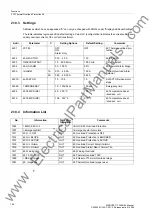
Functions
2.11 Monitoring Functions
SIPROTEC, 7SJ62/64, Manual
C53000-G1140-C207-2, Release date 01.2008
197
2.11
Monitoring Functions
The device is equipped with extensive monitoring capabilities - both for hardware and software. In addition, the
measured values are also constantly monitored for plausibility, therefore, the current transformer and voltage
transformer circuits are largely integrated into the monitoring.
2.11.1
Measurement Supervision
2.11.1.1 General
The device monitoring extends from the measuring inputs to the binary outputs. Monitoring checks the hard-
ware for malfunctions and impermissible conditions.
Hardware and software monitoring described in the following are enabled continuously. Settings (including the
possibility to activate and deactivate the monitoring function) refer to the monitoring of external transformer cir-
cuits.
2.11.1.2 Hardware Monitoring
Auxiliary and Reference Voltages
The processor voltage of 5 V DC is monitored by the hardware since the processor will no longer be functional
if the voltage falls below the minimum value. In that case, the device is put out of operation. When the supply
voltage returns, the processor system is restarted.
Failure of or switching off the supply voltage removes the device from operation and a message is immediately
generated by a normally closed contact. Brief auxiliary voltage interruptions of less than 50 ms do not disturb
the readiness of the device (for nominal auxiliary voltage > 110 VDC).
The processor monitors the offset and reference voltage of the ADC (analog-digital converter). The protection
is suspended if the voltages deviate outside an allowable range, and lengthy deviations are reported.
Buffer Battery
The buffer battery, which ensures operation of the internal clock and storage of counters and messages if the
auxiliary voltage fails, is periodically checked for charge status. If it is less than an allowed minimum voltage,
then the
„Fail Battery“
message is issued.
Memory Components
All working memories (RAMs) are checked during startup. If a malfunction occurs then, the starting sequence
is interrupted and an LED blinks. During operation the memories are checked with the help of their checksum.
For the program memory, the cross sum is formed cyclically and compared to the stored program cross sum.
For the settings memory, the cross sum is formed cyclically and compared to the cross sum that is freshly gen-
erated each time a setting process takes place.
If a fault occurs the processor system is restarted.
Scanning
Scanning and the synchronization between the internal buffer components are constantly monitored. If any de-
viations cannot be removed by renewed synchronization, then the processor system is restarted.
www
. ElectricalPartManuals
. com
















































